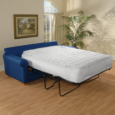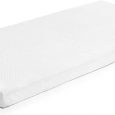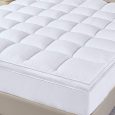
Memory foam toppers are popular for their ability to provide body support and cushioning in any sleeping position. They adjust according to your body shape and temperature, compressing when you shift positions then returning to their original form when released. Unfortunately, over time they start losing their effectiveness and become saggy and uncomfortable.
How Often Should You Replace Your Memory Foam Topper?
The lifespan of any mattress topper depends on its thickness, quality, and how well it’s taken care of. For instance, one that isn’t properly cleaned and flipped will wear out faster than one which has been well taken care of.
When to Flip It
If you’re purchasing a memory foam topper to provide extra support to a sagging mattress, flipping it once or twice annually can extend its lifespan. However, keep in mind that adding too much pressure may increase the sagging mattress’s symptoms; thus, this solution may not be ideal for everyone.
When to Replace It
If the topper is starting to sag, it may be time for a replacement. As a general guideline, most toppers need replacing every 18-36 months.
High-density memory foam toppers should have a lifespan of 3-5 years; on the other hand, cheaper models with lower quality materials may only last 1-2 years.
Type of material
Mattress toppers made of natural latex, such as Dunlop or Talalay latex, tend to last longer than synthetic alternatives. On average, they will last 3-6 years.
If you’re searching for a mattress topper that provides soft cushioning, pressure point relief or reliable body support, there are plenty of options to choose from. Ultimately, the right mattress topper for you will depend on your individual needs, comfort preferences and budget.
The thickness
Memory foam toppers are an excellent way to add comfort and support to an existing mattress, however they have a limited lifespan if not taken care of properly.
The material of your Memory Foam Topper is essential in determining its lifespan. Thinner models tend to wear out faster than thicker models due to increased exposure to moisture and other elements.
Memory foam topper made with thicker material will be able to bear the brunt of body weight and pressure better, extending their lifespan and providing added comfort while sleeping.
Thin toppers that are only 1 inch or thinner will wear out faster than those 3 inches or more in thickness, since there’s not as much depth or material to provide support.
If your memory foam topper is looking worn, it may be time for a replacement. Rotating it every 3-6 months can help redistribute any natural body impressions that have developed on one side due to prolonged use.
How to get the best out of your memory foam mattress topper
The Temperature
Memory foam is a temperature-sensitive material, meaning that it responds to changes in ambient room temperatures. In colder environments, memory foam may feel stiffer and take longer for contours to form.
Memory foam mattresses can still be comfortable in the wintertime, but it requires some planning and preparation in order to make it comfortable.
Prior to going to bed, warm your bedroom up so the memory foam has time to soften and become more malleable.
If your memory foam topper is prone to overheating, consider investing in a topper that’s infused with cooling gel or invest in bed frames and bedding that are cooler and breathable.
Sheets, comforters and duvets made from low thread count materials such as Tencel(r), cotton, linen or bamboo can be an effective way to regulate the temperature of your mattress. By using these materials during sleep, you’ll keep cool while sleeping and make the memory foam topper even more efficient at regulating body heat.
Maintenance
Maintaining the cleanliness of a memory foam mattress topper is essential for its longevity. Regular vacuuming helps prevent accumulation of dust and other particles, giving your mattress more life.
Spot Clean Stains
To keep your memory foam mattress topper looking its best, regularly spot-clean it. A mixture of water and vinegar can be used for this task. Make a solution of equal parts white vinegar and cold water, spray on any spots that need clearing up, then leave the solution on for at least 15 minutes before wiping with a damp cloth.
Spot-cleaning stains is essential to avoid them settling into the mattress topper.
Remove Smells
If your mattress topper is beginning to develop a smell, sprinkle baking soda over it and let sit for 8 hours or up to overnight. This will help eliminate any odor-causing bacteria.
You can even use a steam cleaner to tackle tough stains and odors, but be sure to read the manufacturer’s care instructions first.
Experts typically recommend replacing a memory foam topper after five to seven years, though this timeframe can vary based on several factors. The quality of your mattress topper is key; if it breaks down rapidly due to cheap construction, then it could be an indication that it’s time to replace your memory foam topper.
Keep It Dry
One of the most effective way to extend the life of your memory foam mattress topper is by making sure it’s dry when you wake up in the morning.
It’s essential to air out your memory foam mattress topper before placing it back on the bed. Doing this will eliminate excess moisture and eliminate odours from the topper as well as extend its lifespan.



